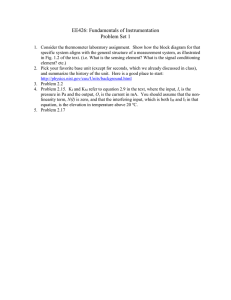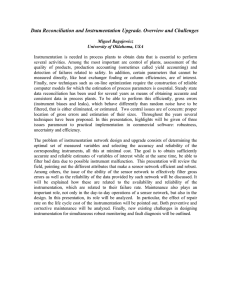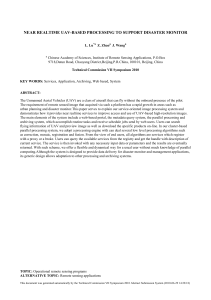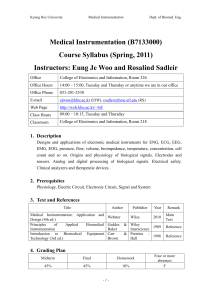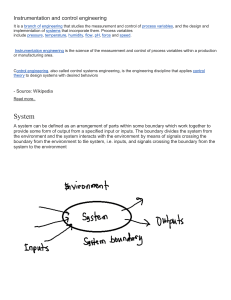Interdisciplinary State-of-the-art Technology Systems for Agriculture and Military Applications Abstract:
advertisement
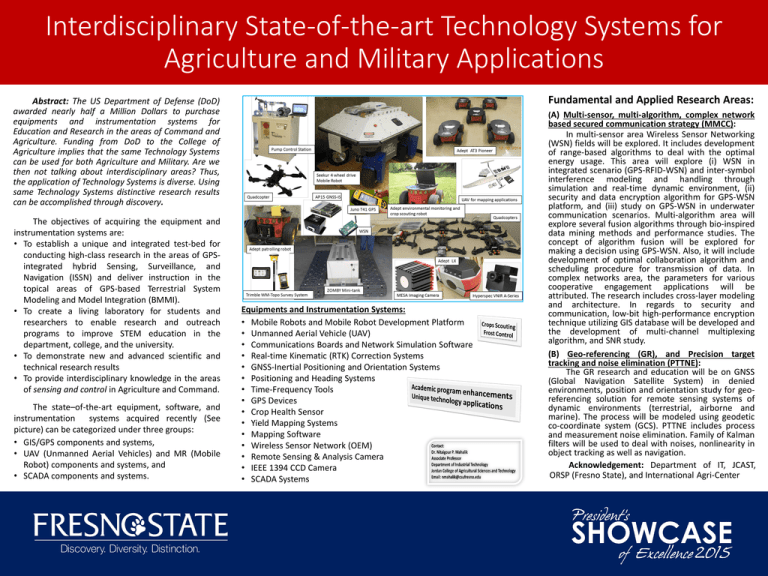
Interdisciplinary State-of-the-art Technology Systems for Agriculture and Military Applications Fundamental and Applied Research Areas: Abstract: The US Department of Defense (DoD) awarded nearly half a Million Dollars to purchase equipments and instrumentation systems for Education and Research in the areas of Command and Agriculture. Funding from DoD to the College of Agriculture implies that the same Technology Systems can be used for both Agriculture and Military. Are we then not talking about interdisciplinary areas? Thus, the application of Technology Systems is diverse. Using same Technology Systems distinctive research results can be accomplished through discovery. The objectives of acquiring the equipment and instrumentation systems are: • To establish a unique and integrated test-bed for conducting high-class research in the areas of GPSintegrated hybrid Sensing, Surveillance, and Navigation (ISSN) and deliver instruction in the topical areas of GPS-based Terrestrial System Modeling and Model Integration (BMMI). • To create a living laboratory for students and researchers to enable research and outreach programs to improve STEM education in the department, college, and the university. • To demonstrate new and advanced scientific and technical research results • To provide interdisciplinary knowledge in the areas of sensing and control in Agriculture and Command. The state–of-the-art equipment, software, and instrumentation systems acquired recently (See picture) can be categorized under three groups: • GIS/GPS components and systems, • UAV (Unmanned Aerial Vehicles) and MR (Mobile Robot) components and systems, and • SCADA components and systems. (A) Multi-sensor, multi-algorithm, complex network Equipments and Instrumentation Systems: • Mobile Robots and Mobile Robot Development Platform • Unmanned Aerial Vehicle (UAV) • Communications Boards and Network Simulation Software • Real-time Kinematic (RTK) Correction Systems • GNSS-Inertial Positioning and Orientation Systems • Positioning and Heading Systems • Time-Frequency Tools • GPS Devices • Crop Health Sensor • Yield Mapping Systems • Mapping Software • Wireless Sensor Network (OEM) • Remote Sensing & Analysis Camera • IEEE 1394 CCD Camera • SCADA Systems based secured communication strategy (MMCC): In multi-sensor area Wireless Sensor Networking (WSN) fields will be explored. It includes development of range-based algorithms to deal with the optimal energy usage. This area will explore (i) WSN in integrated scenario (GPS-RFID-WSN) and inter-symbol interference modeling and handling through simulation and real-time dynamic environment, (ii) security and data encryption algorithm for GPS-WSN platform, and (iii) study on GPS-WSN in underwater communication scenarios. Multi-algorithm area will explore several fusion algorithms through bio-inspired data mining methods and performance studies. The concept of algorithm fusion will be explored for making a decision using GPS-WSN. Also, it will include development of optimal collaboration algorithm and scheduling procedure for transmission of data. In complex networks area, the parameters for various cooperative engagement applications will be attributed. The research includes cross-layer modeling and architecture. In regards to security and communication, low-bit high-performance encryption technique utilizing GIS database will be developed and the development of multi-channel multiplexing algorithm, and SNR study. (B) Geo-referencing (GR), and Precision target tracking and noise elimination (PTTNE): The GR research and education will be on GNSS (Global Navigation Satellite System) in denied environments, position and orientation study for georeferencing solution for remote sensing systems of dynamic environments (terrestrial, airborne and marine). The process will be modeled using geodetic co-coordinate system (GCS). PTTNE includes process and measurement noise elimination. Family of Kalman filters will be used to deal with noises, nonlinearity in object tracking as well as navigation. Acknowledgement: Department of IT, JCAST, ORSP (Fresno State), and International Agri-Center
